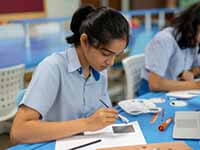Good educators understand the individuality of a child. They know that not all children learn at the same pace. They also absorb lessons in a variety of ways. That’s why some students learn faster when they read, while others learn more effectively through hands-on activities. Some are better listeners, and others excel at writing.
Understanding how your child learns is an essential step to getting them the best education possible. By finding out what type of learner your child is, you can pick a school that’s a match for the learning style that your child prefers. With plenty of international schools in Singapore, you’ll have plenty of options to look over.
Find Our Learning Style of Your Child with These Tips
1. Start with the Basics
You’ll need to know the four primary learning styles. There’s visual and auditory along with reading or writing, and then kinesthetic. Some students use a combination of each, but they usually have one style that works exceptionally well. That’s what you need to find out. There is a good reason for this. By using the right learning style, your child will understand and retain information much better. You can also choose better study methods that work well with your child’s strengths. If your kid is having a hard time with their lessons, if they can’t seem to retain the information, then the study method you’re using could be derailing their progress.
2. There’s More Than One
Keep in mind that some kids have more than one learning style that works for them. Your child might fall into two or three learning style categories. The best way to find out which one works most effectively is to try out each one. That means you should keep exploring. If you try one out and it seems to work, don’t stop there. Move on to other learning styles until you see just how well your kid reacts to each approach. That way, you can tell which option should be at the top of the list.
3. Consider Visual Activities
The most common learning style is visual learning. If your child has a skill for drawing or making art, loves books that come with illustrations like graphs, maps, and pictures, has a talent for recognizing as well as recalling people, words, and places visually and does best when you provide an example of the problem that they should be working on, then these are all signs that your child is a visual learner. If that is the case, using flashcards is an excellent way to review the lessons. You can also create charts and maps to help them study. For the notes, use different colours to differentiate between items.
4. Look for Auditory Cues
If your child is good at music, loves to sing and hum, or talks while playing or doing assignments from school, those are signs that they are auditory learners. Other signs include the ability to follow verbal instructions with ease, talking or having conversations with others, excellent listening skills to instructions before starting a task, and asking many questions when finishing up an activity or working on a task. For auditory learners, the best study tip is to get them to recite study notes out loud. You could also talk your child through areas that they seem to be struggling with.
5. Switch to Reading or Writing
Some kids need to write things down or take notes when they’re working on completing a task. Some enjoy reading books or even writing tales and stories of their own. Some are best at remembering something they’ve read. These kids all share one quality: they are reading or writing learners. They often study best when they’re alone in a quiet space. If you want to provide your child with the support they need, then daily checklists that could serve as a study guide will be a huge help. You could also teach your kid how to organise study notes with lists and headings.
6. Kinesthetic Learner
A kinesthetic learner is excellent at physical activities. He shines in sports and needs to be up and about all the time. If your child is like theirs, then they probably have a hard time sitting while learning. He enjoys hands-on activities the best and loves those that include active listening or study games. While other kids will go slowly over the instructions, your child is of the mind that it’s better to dive straight into a task and get started. You can improve your child’s study habits and retention to find ways to transform studying into a fun game or activity. Get a stress ball. That will help them study. Also, you’ll want to create practice tests. Those will set expectations and lower stress.
7. Learn How to Motivate
Whatever kind of learner your child is, it’s essential to be patient. You can do experiments together or indulge in fun activities to get your kid to learn more. If your kid is having a tough time at school, knowing the right learning style can make a huge difference. You can use that to motivate them to work harder. With the right encouragement, your child could power through difficult lessons and reach a breakthrough in their studies.
8. Talk to Their Teacher
Find out more about your child’s study habits by talking to their teacher. Sometimes, it can be surprising to know that your kid has done well in certain activities. A video call with their teacher or class advisor will give you a clearer sense of how they are in class and school, what they like to do and more. Maybe the teacher will show you a drawing that your child made. Or show you a writing assignment that shows a lot of promise and skill for someone so young. The instructor might also mention some of the issues that your child could be having. Are you aware of those issues?
9. Transfer to Another School
With a teacher that’s trained in learning styles, your child can easily improve their talents. That’s why it matters where your child goes to school. If you want attentive instructors who are aware of the different learning styles, who know that kids do not all learn at the same pace and are, therefore, patient with them, then you’ll want to check out international schools in the city. There are plenty of options but finding one with top notch teaching staff is a smart move.
Finding a school with teachers that have the necessary training to recognise which learning style fits your child doesn’t happen by luck, though. Make sure you do your homework. Find out more about the school and its facilities. What kind of teaching philosophy or method does it use? That matters, too. Traditional learning styles are usually all about the teacher being at the centre of the discussion, giving a lecture while the students listen. Schools that use a Montessori learning style encourage the kids to be at the centre of the discussion, with teachers taking on a facilitator’s role. They observe, they let the kids drive the discussion, they steer it back when it gets side-tracked, but they essentially let the students handle the reins. That learning style acknowledges the different study methods, too, encouraging kids to engage in experiential learning.

































